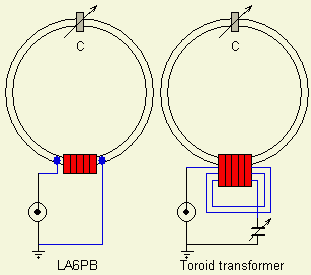LA6PB's SPLIT DIPOLE
A new method of feeding a dipole with toroids.
![]() 8 Aug 2015 More info about the ferrite beads.
8 Aug 2015 More info about the ferrite beads.
|
|
LA6PB calls his idea "Split Dipole" |
INTRODUCTION
The well known ferrite bead sleeve balun was introduced by W2DU, W. Maxwell. (QST March 1983.) I have this balun installed on all my coax feeders. One day it occurred to me that these ferrite beads could be used to split a conductor and thereby create a dipole.
A quick experiment confirmed my assumption: 50 Amidon beads no. 73 were strung on the centre of an approx. 5 m long wire. The ubiquitous MFJ SWR-meter was connected to each side of the bead sleeve, and indeed right, showed resonance and a low SWR. What practical use could this discovery lead to?
EXPERIMENT
Some time ago I was given a solid aluminium rod, 4.66 m long and 12 mm diameter. From an old TVI problem I had some ferrite toroids, type Philips 4330-030-3445, OD/ID: 36/21 mm, W: 15 mm. I am convinced that you can get similar toroids in EU and the US, anyhow, you may try whatever you have in your junk-box.
I put 5 of these ferrite toroids at the centre of this Al-rod, and placed the rod 2 m above ground. Again the theory was confirmed; I found resonance at 28,4 MHz.
The transmitter was connected to the antenna. With an output of 200 W there was very little heating of the toroids, but with 500 W the toroids became a little warm.
The number of toroids were increased to 8 (schematic), then there was no heating at 200 W, and a very modest heating at 500 W after some minutes key down.
CONSTRUCTION
The toroids were mounted with some insulation on the rod, so that they sit tight, and a plastic wafer at each end. Two stainless steel hose clamps hold two right angles bent stainless strips to the rod, and the coax, properly sealed against water is connected to the stainless strips. The coax itself is clamped to one of the strips. See the photo.
After these tests I climbed a pine tree and mounted the aluminium rod horizontally ca 10 m above earth, taped to two branches on each side of the toroids.
RESONANCE
The resonant frequency was now found to be 29.2 MHz, but the SWR curve was so flat that I measured:
|
28 MHz |
SWR = 1.2 |
|
29.2 MHz |
SWR = 1 |
|
29.7 MHz |
SWR = 1.1 |
Both my transceiver and my transistorised 500 W PA give full power over the whole 10 m band without use of the build-in antenna tuner!
From earlier experience I know that ferrite beads are not subject to corrosion. I have had beads exposed to outdoor weather for years without any sign of corrosion. This new antenna with the toroids has now survived two years without any problem.
What was meant, as an experiment has become a permanent antenna.
ADVANTAGE
What is the advantage with this "Ferrite Split Dipole"?
|
After installing the toroids, there is no need for any post-installation and |
|
adjustments compared to gamma, T-match or other matching methods. |
|
Mechanical strength, only one solid rod or tube. |
|
Suitable for one single support can easily be rotated. |
PERFORMANCE
Then the inevitable question: How does this antenna perform on the air? In the CQWWCW contest Nov. 2000, I worked 70 countries on all six continents with 100 W. I am very pleased with this antenna.
John Lien, LA6PB, lien.j@frisurf.no

NOTE (PAØFRI):
Left figure: His idea can be used to feed a magnetic loop antenna.
Right figure: A couple of toroids as transformer to match the low impedance of the loop to 50 Ohm. Eventually with an extra loading capacitor for easy matching.
TOROID
PE1ABR provided more information. The Philips 4330-030-3445 toroid is also know as rose 36 mm dia type 4A11. An Amidon compatible type is FT140-43.
![]()